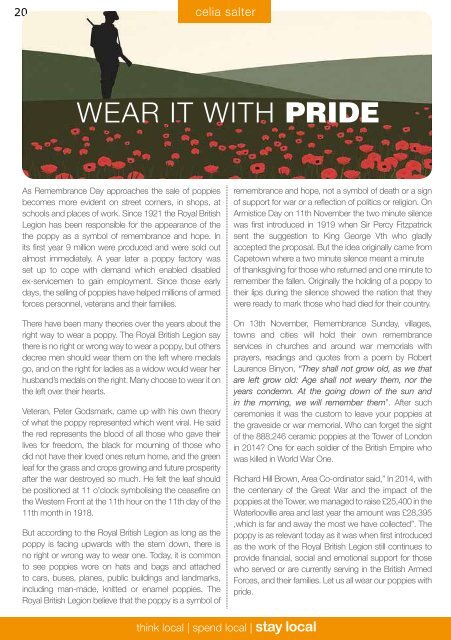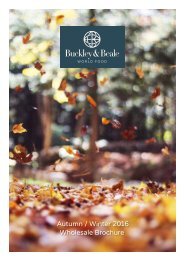Clanfield & Horndean
Create successful ePaper yourself
Turn your PDF publications into a flip-book with our unique Google optimized e-Paper software.
20<br />
celia salter<br />
WEAR IT WITH PRIDE<br />
As Remembrance Day approaches the sale of poppies<br />
becomes more evident on street corners, in shops, at<br />
schools and places of work. Since 1921 the Royal British<br />
Legion has been responsible for the appearance of the<br />
the poppy as a symbol of remembrance and hope. In<br />
its first year 9 million were produced and were sold out<br />
almost immediately. A year later a poppy factory was<br />
set up to cope with demand which enabled disabled<br />
ex-servicemen to gain employment. Since those early<br />
days, the selling of poppies have helped millions of armed<br />
forces personnel, veterans and their families.<br />
There have been many theories over the years about the<br />
right way to wear a poppy. The Royal British Legion say<br />
there is no right or wrong way to wear a poppy, but others<br />
decree men should wear them on the left where medals<br />
go, and on the right for ladies as a widow would wear her<br />
husband’s medals on the right. Many choose to wear it on<br />
the left over their hearts.<br />
Veteran, Peter Godsmark, came up with his own theory<br />
of what the poppy represented which went viral. He said<br />
the red represents the blood of all those who gave their<br />
lives for freedom, the black for mourning of those who<br />
did not have their loved ones return home, and the green<br />
leaf for the grass and crops growing and future prosperity<br />
after the war destroyed so much. He felt the leaf should<br />
be positioned at 11 o’clock symbolising the ceasefire on<br />
the Western Front at the 11th hour on the 11th day of the<br />
11th month in 1918.<br />
But according to the Royal British Legion as long as the<br />
poppy is facing upwards with the stem down, there is<br />
no right or wrong way to wear one. Today, it is common<br />
to see poppies wore on hats and bags and attached<br />
to cars, buses, planes, public buildings and landmarks,<br />
including man-made, knitted or enamel poppies. The<br />
Royal British Legion believe that the poppy is a symbol of<br />
remembrance and hope, not a symbol of death or a sign<br />
of support for war or a reflection of politics or religion. On<br />
Armistice Day on 11th November the two minute silence<br />
was first introduced in 1919 when Sir Percy Fitzpatrick<br />
sent the suggestion to King George Vth who gladly<br />
accepted the proposal. But the idea originally came from<br />
Capetown where a two minute silence meant a minute<br />
of thanksgiving for those who returned and one minute to<br />
remember the fallen. Originally the holding of a poppy to<br />
their lips during the silence showed the nation that they<br />
were ready to mark those who had died for their country.<br />
On 13th November, Remembrance Sunday, villages,<br />
towns and cities will hold their own remembrance<br />
services in churches and around war memorials with<br />
prayers, readings and quotes from a poem by Robert<br />
Laurence Binyon, “They shall not grow old, as we that<br />
are left grow old: Age shall not weary them, nor the<br />
years condemn. At the going down of the sun and<br />
in the morning, we will remember them”. After such<br />
ceremonies it was the custom to leave your poppies at<br />
the graveside or war memorial. Who can forget the sight<br />
of the 888,246 ceramic poppies at the Tower of London<br />
in 2014? One for each soldier of the British Empire who<br />
was killed in World War One.<br />
Richard Hill Brown, Area Co-ordinator said,” In 2014, with<br />
the centenary of the Great War and the impact of the<br />
poppies at the Tower, we managed to raise £25,400 in the<br />
Waterlooville area and last year the amount was £28,395<br />
,which is far and away the most we have collected”. The<br />
poppy is as relevant today as it was when first introduced<br />
as the work of the Royal British Legion still continues to<br />
provide financial, social and emotional support for those<br />
who served or are currently serving in the British Armed<br />
Forces, and their families. Let us all wear our poppies with<br />
pride.<br />
think local | spend local | stay local








